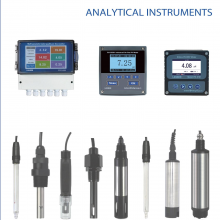
CLDS710 Digital Residual Chlorine Sensor Electrode principle characteristics:
Constant voltage principle electrode is used to measure residual chlorine or hypochlorous acid in water. The constant voltage measurement method is to maintain a stable potential at the electrode measuring end, and different measured components produce different current intensities under this potential. It consists of two platinum electrodes and a reference electrode to form a micro current measurement system. The residual chlorine or hypochlorous acid in the water sample flowing through the measuring electrode will be consumed. Therefore, the water sample must be kept flowing continuously through the measuring electrode during measurement.
The constant voltage measurement method uses a secondary instrument to continuously and dynamically control the potential between the measuring electrodes, eliminating the inherent resistance and oxidation-reduction potential of the measured water sample, so that the electrode can measure the current signal and the measured water sample concentration A good linear relationship is formed between them, with a very stable zero point performance, ensuring accurate and reliable measurement.
The constant voltage electrode has a simple structure and a glass appearance. The front end of the online residual chlorine electrode is a glass bulb, which is easy to clean and replace. When measuring, it is necessary to ensure that the water flow rate through the residual chlorine measuring electrode is stable.
Residual chlorine or hypochlorous acid. This product is a digital sensor that integrates electronic circuits and microprocessors inside the sensor, referred to as digital electrode.
Constant voltage residual chlorine digital electrode sensor (RS-485) Features
1. Power supply and output isolation design to ensure electrical safety
2. Built-in protection circuit for power supply and communication chip, strong anti-interference ability
3. With comprehensive protection circuit design, it can work reliably without additional isolation equipment
4. The circuit is built inside the electrode, which has good environmental tolerance and easier installation and operation
5. RS-485 transmission interface, MODBUS-RTU communication protocol, two-way communication, can receive remote commands
6. The communication protocol is simple and practical and extremely convenient to use
7. Output more electrode diagnostic information, more intelligent
8. The internal integrated memory can still memorize the stored calibration and setting information after power off
9. POM shell, strong corrosion resistance, PG13.5 thread, easy to install.
Application:
Drinking water: ensuring reliable disinfection
Food: to ensure food safety, sanitary bag and bottle methods
Public works: detection of residual chlorine
Pool water: efficient disinfectant
No additional instrument is required, 485 signal transmission, no interference on site, easy to integrate into various systems, and effectively reduce related use costs.
The electrodes can be calibrated in the office or laboratory, and replaced directly on site, without additional on-site calibration, which greatly facilitates later maintenance
Calibration information record is stored in electrode memory.
CLDS710 Digital Residual Chlorine Sensor Electrode
Model NO.: CLDS710
Power/Signal Output: 9~36VDC/RS485 MODBUS RTU 4~20mA(Optional)
Measurement method: Potentiostatic
Housing material: Glass+POM
Waterproof grade: IP68
Measurement range: 0-2mg/L;0-10mg/L;0-20mg/L
Accuracy: ±1%F.S
Pressure range: ≤0.3Mpa
Temperature compensation: NTC10K
Temperature range: 0-80ºC
Calibration: Water sample, chlorine-free water and standard liquid
Connection methods: 4 core cable
Cable length: Standard 10m cable or extended to 100m
Installation thread: PG13.5
Application: Tap water, pool water, etc



